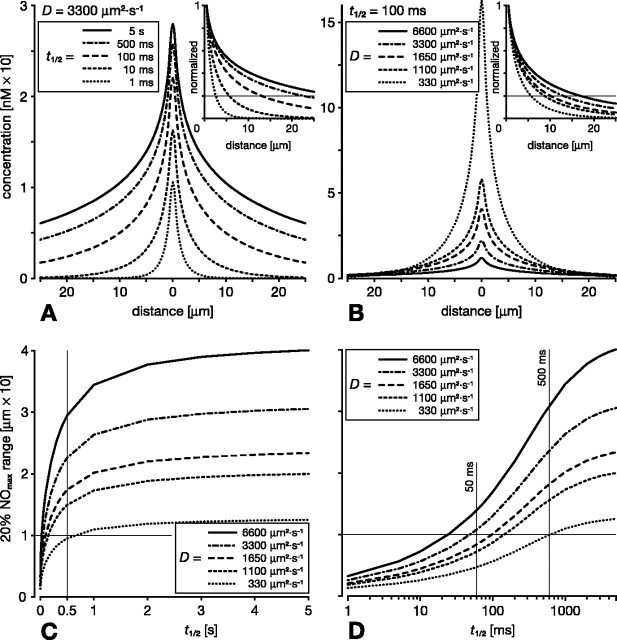Figure 3.
Influence of half-life (t1/2) and diffusion coefficient (D) on the spread of NO from a single fiber of 1 μm diameter after 1 s of continuous NO synthesis. Main plots in A and B show the absolute NO concentrations plotted against distance from the center of the fiber. In the insets, these concentrations are normalized to the concentration at the fiber surface. The distance over which the concentration drops to 20% of the surface concentration (the 20% NOmax range; hairline in insets) serves as a measure of the relative spread. A, Varying t1/2 5000-fold between 5 s and 1 ms while keeping D constant at 3300 μm2 · s-1 has little effect on the NO concentration at the source (∼30 and ∼10 nm, respectively). Although concentrations are affected more at distant points (as is evident from the diverging lines in the inset), the spread is curtailed significantly only when t1/2 is substantially shorter than 100 ms. For example, 10 μm away from the source, the concentration is only halved by reducing t1/2 from 5 s to 100 ms. Likewise, the 20% NOmax range drops below 10 μm only when t1/2 is significantly shorter than 100 ms (hairline in inset). B, Varying D between 2× and 0.1× its standard value while keeping t1/2 constant at 100 ms impacts on the absolute concentration at the source but has much less effect at more distant points. The relative spread is likewise little affected (inset in B). A significant drop of the 20% NOmax range below 10 μm is predicted only with D = 330 μm2 · s-1, 1/10 of its standard value. C, D, The 20% NOmax range shown as a function of t1/2 for different D values. C, Varying t1/2 between 5 and ∼0.5 s has no significant effect on the spread, and the 20% NOmax range is 10 μm or more even for D = 330 μm2 · s-1 (crossed hairlines). D, Over the range of t1/2 = 50-500 ms, spread changes more steeply. Importantly, however, with physiologically realistic values of D > 1000 μm2 · s-1, the 20% NOmax range is of the order of 10 μm or more (crossed hairlines).

